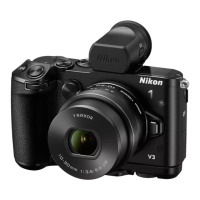220
g
Check and optimize the camera image sensor and image proces-
sors if you notice unexpected bright spots in your pictures (note
that the camera comes with the sensor and processors already
optimized). Before performing pixel mapping as described
below, check that the battery is fully charged.
1
Attach a lens and lens cap.
Turn the camera off and attach a 1 NIKKOR lens. If the lens is
equipped with a cap, do not remove it.
2
Select Pixel mapping.
Turn the camera on, press G, and select Pixel mapping in
the setup menu.
3
Select Ye s .
Pixel mapping begins immediately. Note that other opera-
tions can not be performed while pixel mapping is in
progress. Do not turn the camera off or remove or disconnect
the power source until pixel mapping is complete.
4
Turn the camera off.
Turn the camera off when pixel mapping is complete.
Pixel Mapping

